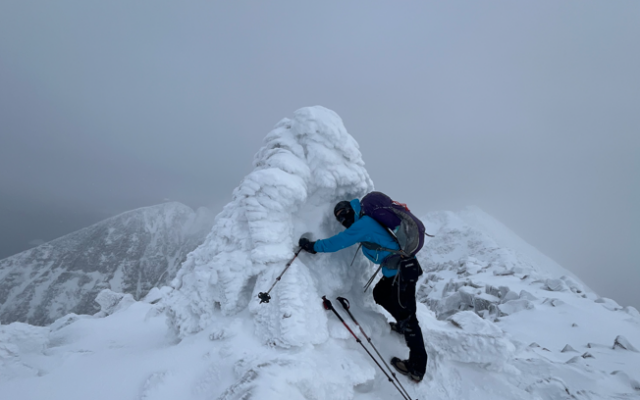
These are the relative risks to winter mountaineering
By Ron Chase
A few weeks ago, I wrote a column about my son, Adam, and me climbing Williams Mountain in western Maine. The trek occurred on the first day of winter and, as I described, we encountered strong winds and severe wind chills.
One reader submitted a comment about the article: “Projected icy trails, high winds, and severe wind chills. I would hope that most folks have the common sense to avoid such conditions.â€
The writer appears to suggest that we exercised poor judgment by choosing to hike in cold, windy weather.
I disagree.
As with most endeavors, fitness, experience and equipment need to be factored into the equation. We were well prepared for the conditions.
The writer is certainly entitled to his or her opinion. I’m convinced the most dangerous thing that Adam and I did that day was to drive to and from the trailhead.Â
Driving is something that the vast majority of us do every day. About 40,000 Americans die in car accidents each year and approximately 2.5 million are injured, according to the National Highway Traffic Safety Administration. I try to minimize the risks by driving defensively.
The reader’s comments motivated me to consider the relative hazards of winter mountaineering.
Unlike driving, most people are not familiar with climbing mountains in winter. In fact, it’s a relatively low risk activity compared against other winter sports.
For instance, according to the Maine Center for Disease Control, an average of six people die each year snowmobiling in Maine. Sadly, every winter a few Maine skaters, fishermen and other adventurers fall through the ice and drown.
My research indicates there are also occasional downhill skiing fatalities in Maine. Eight years ago, a friend died in Baxter State Park of a presumed heart attack while hiking on park roads in winter.
I can’t find any record of a recent winter mountaineering death in Maine due to the elements.
The unknown is often a cause for fear or concern for most of us. I wouldn’t jump out of an airplane with a parachute unless I was certain it was going to crash.
I suspect that when many people think about winter hiking in the mountains, they visualize the worst-case scenarios and consider the venture life-threatening.
I started winter hiking with my wife, Nancy, family and friends about 45 years ago. Our son, Adam, began joining us on winter outings at a young age. He climbed Katahdin in the winter when he was 13.
About thirty years ago, I connected with a group of friends called peak baggers in an attempt to climb the 100 highest peaks in New England in winter. Ten of us completed the list.
Winter mountaineering is an integral part of our lives; as normal for us as others might consider a Sunday afternoon drive. Both activities are potentially dangerous. That’s where evaluating the risks and assessing one’s ability to deal with them become important factors.
I wouldn’t go for a Sunday afternoon drive during a snowstorm. I wouldn’t have driven to Williams Mountain in a snowstorm. I wouldn’t have climbed Williams Mountain if I believed it was dangerous. And, if conditions had deteriorated, we would have turned back.
Safety is important in any endeavor. For me, that’s true with winter mountaineering and virtually every other activity. Sometimes people have terrible accidents during Sunday afternoon drives and occasionally climbers die in the mountains.
I don’t believe that’s a reason to forgo them.
Recently, four friends entered Baxter State Park with the intention of climbing Katahdin. All of them are in their 60s and 70s; one a grandmother. Severe winter conditions were forecast for their multi-day quest. They were experienced, well-equipped and carefully evaluated the weather each day.
On the final possible day, the weather improved and they reached the summit. A few may question the common sense of that undertaking. I think they did a superb job of assessing the circumstances and safely achieving their goal.
Next week, friends and I are beginning a Baxter State Park expedition. We anticipate skiing, snowshoeing, mountain hiking, technical climbing and hauling heavy sleds.
I hope to return with interesting stories to relate.
We’ll likely experience some stormy weather. I predict the most hazardous thing we’ll do is drive to and from the park.
My book, “Maine Al Fresco: The Fifty Finest Outdoor Adventures in Maine†narrates 50 wonderful Maine outdoor escapades. All of them are potentially dangerous.